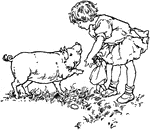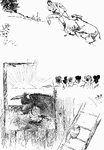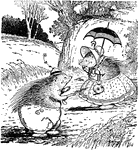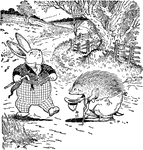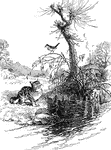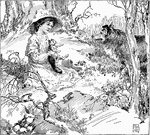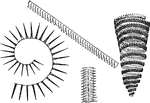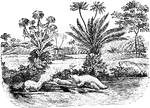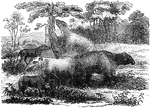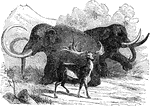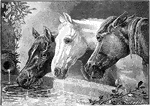
Deep Sea Dredge
"A deep-sea dredge. The iron lip of the sack scrapes shells mud, etc., into it, and small animals are…
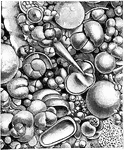
Ooze
"One third of the sea bottom is covered with a soft gray ooze or mud made up entirely of the shells…
Man and Animals Divider
A decorative divider with a man in the center, surrounded by plants and animals.
Animal Divider
A decorative divider with wheat in the center, surrounded by dogs, rabbits, and other plants.
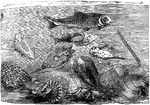
Paleozoic Animals
"Fish, trilobites, brachiopods, corals, and graptolites of the Palaeozoic epoch." -Taylor, 1904
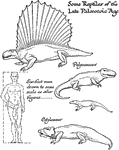
Reptiles of the late Paleozoic age
Some reptiles of the Late Paleozoic Age. The six-foot man is drawn to the same scale as the other animals.

Mesozoic Age Reptiles
Some Mesozoic reptiles. Shown are the Brontosaurus, Stegosaurus, Pterodactyl, Camptosaurus, and the…
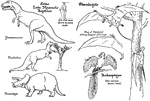
Late Mesozoic Age Reptiles
Some Late Mesozoic reptiles. Shown are the Tyrannosaurus, Trachodon, Triceratops, Pterodactyls, and…
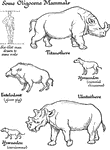
Mammals from the Oligocene Mammals
Mammals from the Oligocene age. Shown are the Titanothere, Entelodont, Hyracodon, Uintathere, and the…

Freshwater Hydra
A freshwater hydra, magnified. Example of an animal with no skeleton. There are animals without a skeleton…

Diagram of the Body Plan
Plan of the body in cross-section. The systems in the body are arranged in a certain way which is the…
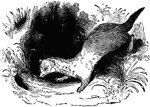
Ferret
"The Ferret was imported into Europe from Africa, and was well known to the Romans, being anciently…
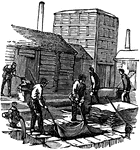
Leather Making, the Tan-yard
Leather making consists essentially of the skins of animals chemically altered by the vegetable principle…
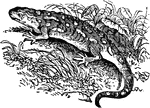
Cold Blooded Salamander
The name given to various animals included in the class Amphibia and in the order Urodela of that class.…

Arachnid Scorpion
The name of animals of the class Arachnida. Scorpions have an elongated body, suddenly terminated by…

Frog Blood Corpuscles
Blood corpuscles of a frog. Highly magnified. The appearance of blood cells in different animals varies…
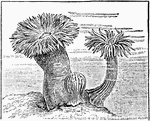
Sea Anemones
The popular name given to a number of animals of the subkingdom Coelenterata and class Actinozoa, including…

Sea Hare
The name of a genus of gasteropodous mollusca. These animals are slug-like in appearance, and derive…

Skeleton of a Haddock
The skeleton of a haddock. In some species such as the haddock, there is a modified form of the coracoid…

Diagram of a Mollusca
A diagram of a mollusca. Mollusca are soft-bodied animals that are usually protected by an external…
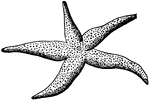
Diagram of a Starfish
A diagram of a radiata (the starfish) whose organization is much less complete than that of most other…

Comparing Teeth of Carnivora and Insectivora Animals
The image on the left are the teeth of a carnivora or flesh-eating animal. The teeth on the right belong…
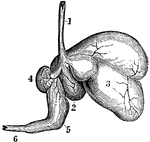
The Stomach of a Sheep
Ruminants (those animals that chew the cud), as the sheep, have a stomach with four cavities. Labels:…
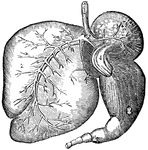
Stomach of an Ox
Ruminants (those animals that chew the cud), as the ox, have a stomach with four cavities. Labels: 1,…
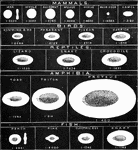
Red Blood Cells in Vertebrata
The illustration exhibits the typical characters of the red blood cells in the main divisions of Vertbrata.…
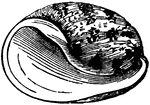
Bulla Ampulla (Linnaeus)
"The animals have a well-developed shell, the form of which is elegant and delicate in structure. They…

Bulla Oblonga (Adams)
"The animals have a well-developed shell, the form of which is elegant and delicate in structure. They…

Bulla Aspersa (Adams)
"The animals have a well-developed shell, the form of which is elegant and delicate in structure. They…
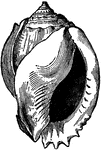
Cassis Glauca (Linnaeus)
"In the genus Cassis the shell is oval, convex, and the spire is not of considerable height.…
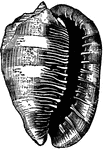
Cassis Rula (Linnaeus)
"In the genus Cassis the shell is oval, convex, and the spire is not of considerable height.…
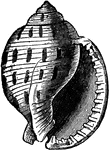
Cassis Canaliculata (Brugieres)
"In the genus Cassis the shell is oval, convex, and the spire is not of considerable height.…
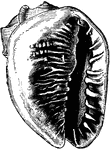
Cassis Madagascariensis (Lamarck)
"In the genus Cassis the shell is oval, convex, and the spire is not of considerable height.…
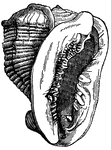
Cassis Madagascariensis (Lamarck)
"In the genus Cassis the shell is oval, convex, and the spire is not of considerable height.…

Cassis Zebra (Lamarck)
"In the genus Cassis the shell is oval, convex, and the spire is not of considerable height.…
!["Cuttlefish are probably the most interesting animals of [the cephalopoda] order. They live for five or six years, and lay eggs, which are large and generally found in clusters, and are known to fishermen as sea-grapes."](https://etc.usf.edu/clipart/51600/51626/51626_sepia_offici_mth.gif)
Sepia Officinalis (Linnaeus)
"Cuttlefish are probably the most interesting animals of [the cephalopoda] order. They live for five…
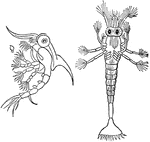
Zoea Taurus
"The lowest division of articulate animals is the Crustacea. Their name signifies a hard crust of covering,…

Internal Anatomy of Birds
"The senses of touch, smell, taste and hearing are very slightly developed in birds. The organ of sight…

Red-Necked Falcon, or Turumdi (Falco Chiquera)
"The falcons, it may be said, realize the ideal of a bird of prey. They feed only on living animals,…

The Fulvous Vulture
"When pressed by hunger it shows no fear in attacking live animals, which makes it dreaded by the shepherds…
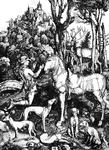
The Conversion of St. Eustace
"The Conversion of St. Eustace. By Albrecht Dürer. From the engraving on copper." -Heath, 1901
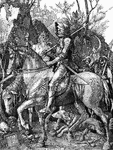
The Knight, Death, and the Devil
"The Knight, Death, and the Devil. By Albrecht Dürer. From the engraving on copper." -Heath, 1901
